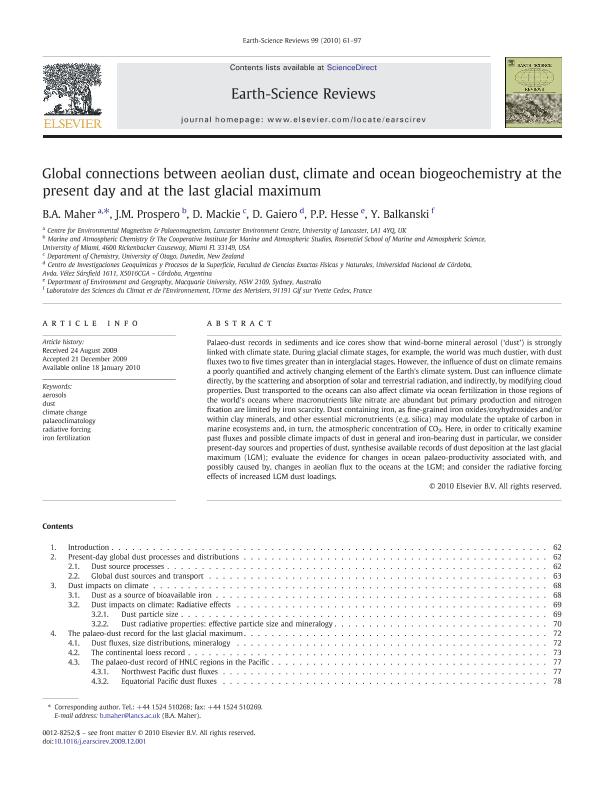Mostrar el registro sencillo del ítem
dc.contributor.author
Maher, B. A.
dc.contributor.author
Prospero, J. M.
dc.contributor.author
Mackie, D.
dc.contributor.author
Gaiero, Diego Marcelo

dc.contributor.author
Hesse, P. P.
dc.contributor.author
Balkanski, Y.
dc.date.available
2018-08-06T17:26:34Z
dc.date.issued
2010-06
dc.identifier.citation
Maher, B. A.; Prospero, J. M.; Mackie, D.; Gaiero, Diego Marcelo; Hesse, P. P.; et al.; Global connections between aeolian dust, climate and ocean biogeochemistry at the present day and at the last glacial maximum; Elsevier Science; Earth-science Reviews; 99; 1-2; 6-2010; 61-97
dc.identifier.issn
0012-8252
dc.identifier.uri
http://hdl.handle.net/11336/54271
dc.description.abstract
Palaeo-dust records in sediments and ice cores show that wind-borne mineral aerosol ('dust') is strongly linked with climate state. During glacial climate stages, for example, the world was much dustier, with dust fluxes two to five times greater than in interglacial stages. However, the influence of dust on climate remains a poorly quantified and actively changing element of the Earth's climate system. Dust can influence climate directly, by the scattering and absorption of solar and terrestrial radiation, and indirectly, by modifying cloud properties. Dust transported to the oceans can also affect climate via ocean fertilization in those regions of the world's oceans where macronutrients like nitrate are abundant but primary production and nitrogen fixation are limited by iron scarcity. Dust containing iron, as fine-grained iron oxides/oxyhydroxides and/or within clay minerals, and other essential micronutrients (e.g. silica) may modulate the uptake of carbon in marine ecosystems and, in turn, the atmospheric concentration of CO2. Here, in order to critically examine past fluxes and possible climate impacts of dust in general and iron-bearing dust in particular, we consider present-day sources and properties of dust, synthesise available records of dust deposition at the last glacial maximum (LGM); evaluate the evidence for changes in ocean palaeo-productivity associated with, and possibly caused by, changes in aeolian flux to the oceans at the LGM; and consider the radiative forcing effects of increased LGM dust loadings.
dc.format
application/pdf
dc.language.iso
eng
dc.publisher
Elsevier Science

dc.rights
info:eu-repo/semantics/openAccess
dc.rights.uri
https://creativecommons.org/licenses/by-nc-sa/2.5/ar/
dc.subject
Aerosols
dc.subject
Climate Change
dc.subject
Dust
dc.subject
Iron Fertilization
dc.subject
Palaeoclimatology
dc.subject
Radiative Forcing
dc.subject.classification
Meteorología y Ciencias Atmosféricas

dc.subject.classification
Ciencias de la Tierra y relacionadas con el Medio Ambiente

dc.subject.classification
CIENCIAS NATURALES Y EXACTAS

dc.title
Global connections between aeolian dust, climate and ocean biogeochemistry at the present day and at the last glacial maximum
dc.type
info:eu-repo/semantics/article
dc.type
info:ar-repo/semantics/artículo
dc.type
info:eu-repo/semantics/publishedVersion
dc.date.updated
2018-08-02T14:49:35Z
dc.journal.volume
99
dc.journal.number
1-2
dc.journal.pagination
61-97
dc.journal.pais
Países Bajos

dc.journal.ciudad
Amsterdam
dc.description.fil
Fil: Maher, B. A.. University of Lancaster; Reino Unido
dc.description.fil
Fil: Prospero, J. M.. Miami University; Estados Unidos
dc.description.fil
Fil: Mackie, D.. University Of Otago; Canadá
dc.description.fil
Fil: Gaiero, Diego Marcelo. Consejo Nacional de Investigaciones Científicas y Técnicas. Centro Científico Tecnológico Conicet - Córdoba. Centro de Investigaciones en Ciencias de la Tierra. Universidad Nacional de Córdoba. Facultad de Ciencias Exactas Físicas y Naturales. Centro de Investigaciones en Ciencias de la Tierra; Argentina
dc.description.fil
Fil: Hesse, P. P.. Macquarie University. Department of Environment and Geography; Australia
dc.description.fil
Fil: Balkanski, Y.. Laboratoire Des Sciences Du Climat Et de L'environnement; Francia
dc.journal.title
Earth-science Reviews

dc.relation.alternativeid
info:eu-repo/semantics/altIdentifier/url/https://www.sciencedirect.com/science/article/pii/S0012825210000024
dc.relation.alternativeid
info:eu-repo/semantics/altIdentifier/doi/http://dx.doi.org/10.1016/j.earscirev.2009.12.001
Archivos asociados
